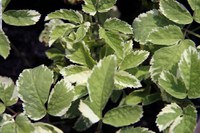Dakota Gardener: Avoid the dreaded garden thugs
(Click an image below to view a high-resolution image that can be downloaded)
By Esther E. McGinnis, Horticulturist
NDSU Extension
Do you have garden thugs in your landscape? These are garden plants that are overly aggressive and try to take over the garden. They are the equivalent of bullies because they refuse to play nice with other plants.
As a young gardener, I made the mistake of purchasing bishop’s weed. The plant looked innocent enough and featured mint green leaves with cream-colored margins. The garden center marketed the plant as a groundcover. That was an understatement! Left unchecked, this garden thug could have covered the entire backyard.
Bishop’s weed has characteristics that aid in its aggression. This perennial has rhizomes, underground stems that creep below the soil’s surface and send out new shoots as it continually spreads.
You may have your own rhizomatous thugs in the garden. Lily of the valley, gooseneck loosestrife, blue lyme grass and mint can all get out of control if not carefully supervised.
Garden thugs can also spread by seed. One spring I transplanted eight beautiful tall verbena plants into my flower garden. With its annual life cycle, I didn’t anticipate problems. However, the next spring, I discovered 1000 seedlings in the same area.
Other garden thugs that self-seed include shasta daisy, golden marguerite and flowering tobacco.
The best way to avoid garden thugs is to research plant characteristics before buying plants at the garden center. However, even the most astute gardener will eventually introduce an aggressive plant into the garden.
To prevent prolific self-seeding, remove the spent flowers before the seeds fall to the ground.
Rhizomatous plants can be contained by the use of barriers such as sidewalks or deep edging. In the case of mint, many gardeners prevent the root system from spreading by encasing the plant in a pot that is sunk into the soil.
When plants get out of control, gardeners can turn to herbicides to get the upper hand. Non-selective herbicides that contain the active ingredient, glyphosphate, can kill aggressive plants. Care must be taken to prevent the herbicide from making contact with desirable plants.
All joking aside, one plant is more serious than all of the previously mentioned garden thugs. Purple loosestrife is more like the mafia and is officially a noxious weed in North Dakota, South Dakota, Minnesota and Montana.
This beautiful but dangerous plant was sold in the garden trade for many decades and is still found in home gardens. Purple loosestrife is a super spreader if it escapes into wetlands and areas adjacent to rivers and streams. It has a competitive advantage because it spreads by both rhizomes and seeds. A plant can produce over 2 million seeds each year. In no time, the noxious weed can form dense colonies that will crowd out native vegetation and deprive wildlife of native habitat.
Garden thugs are a private battle but noxious weeds affect all of us. As gardeners, we can do our part to protect waterways and wetlands by removing purple loosestrife from our home gardens.
NDSU Agriculture Communication – July 19, 2022
Source: Esther McGinnis, 701-231-7971, esther.mcginnis@ndsu.edu
Editor: Kelli Anderson, 701-231-6136, kelli.c.anderson@ndsu.edu




